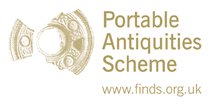Server check!
You are on the training database
Annual report 2004 - 2005
 Download the entire copy for 2004 - 2005
Download the entire copy for 2004 - 2005
The main achievements of the Portable Antiquities Scheme (PAS) in the period 1 April 2004 until 31 March 2005 can be summarised as follows:
Extent of the Scheme
A network of 36 Finds Liaison Officers (FLOs) covers the whole of England and Wales. This is co-ordinated and supported by a central unit of a Head and Deputy Head, Grants & Administration Manager, Education Officer, ICT Adviser and six Finds Advisers.
Recognition of success
In acknowledgement of the Scheme’s success the Government announced it will be fully funding the PAS from April 2006 (when the current period of Heritage Lottery Fund funding ends). In September 2004, an independent evaluation of the Scheme (Review of Portable Antiquities Scheme 2004 – see www.finds.org.uk/news/hawkshead.php) published by Hawkshead Archaeology & Conservation showed that “over 75 per cent of people think that the Scheme has made a positive change in educating finders and raising awareness about the importance of archaeological finds”.
Outreach
425 talks (attended by 13,873 people) have been given about the PAS. 469 Finds Days, exhibitions and other events (attended by 17,219 people) have been organised. More than 3,623 children have experienced the educational work of the Scheme. 298 articles about the work of the Scheme have been published or broadcast.
Social inclusion
A socio-economic analysis of postcode data shows that 47 per cent of people recording finds with the Scheme are from groups C2, D&E, which compares favourably to visitors to museum (29 per cent).1 46 per cent of visitors to a series of Fabulous Finds Days, held nationwide to launch Museums & Galleries Month 2005, had never previously been to that museum before. Liaison The FLOs have liaised with 2,276 finders, attended at least 735 metal-detecting club meetings and 704 other meetings. They maintain regular contact with both metaldetecting clubs and amateur archaeological groups.
Objects recorded
A further 67,213 archaeological objects have been recorded,2 some of which are illustrated in this report. Of these, nearly 79 per cent have been discovered using a metal-detector, and the rest have been found by other means. The FLOs appointed in 2003 have achieved a five fold increase in the reporting of potential Treasure finds.
Findspot information
Almost 89 per cent of finds recorded have been recovered from cultivated land, where they are susceptible to plough damage and artificial and natural corrosion processes. Nearly 75 per cent of finds are now being recorded to the nearest 100 square metres (a six-figure National Grid Reference (NGR) or better, and almost 28 per cent of all finds are being recorded to the nearest 10 square metres (an eight-figure NGR).
Finds data
The finds data generated by the PAS is made available to Historic Environment Records (HERs) – the key record holders for information about the historic environment – and is published on the Scheme’s website – www.finds.org.uk. Agreement (with all interested parties) has now been reached on how PAS data transferred to HERs is used and published online.
Website
There have been over 21 million user hits on the Scheme’s website – www.finds.org.uk – in the period of this report, a threefold increase on 2003/04. At the end of this reporting period the online database allows public access to 92,000 records and 54,000 images.
New sites discovered
Many important new archaeological sites have been discovered as a result of the finds recorded by the FLOs. These include a previously unknown Prehistoric site at Pertenhall, Bedfordshire, new evidence for a Roman coin mint in Norfolk, and England’s first Viking-Age inhumation cemetery at Cumwhitton, Cumbria.
Publication
Several publications associated with the work of the Scheme have appeared in the period of this report, including the Treasure Annual Report 2002, the Portable Antiquities section of Britannia volume 35 (2004), Medieval Archaeology volume 48 (2004) and Bill Wyman’s Treasure Islands.


